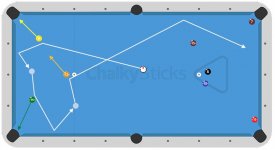The hardest striped ball to get position on to make is going to be the 15 ball, on the right side of the table nearest your opponent's last ball, so that's the one you need to plan as soon as you can to get shape on - and there appears to be no simple natural positioning paths from another ball to get an easy shot on it. If your 11-ball near the lower left corner is preventing the 8-ball from going in the same pocket, a possible strategic move would be to play the combo of your 15 in to his 5-ball, and leaving your 15 ball in/near the pocket jaws and the cue ball on the side rail just above the 2nd diamond. Your opponent should have virtually no shot on the 8-ball - not even a bank, and unless he can figure out a really good safety from there, which would be hard, you're most likely going to be left with an easy rack to run out.
Otherwise, it appears you have little choice but to make your 3 balls up table first, most likely pocketing the 9-ball first, and on the last one, doesn't really matter which, try to bring the cue ball down to the nearest end rail, or try to fall behind the 15 for a shot on it. Assuming you don't fall good on the 15 ball, then shoot your 11-ball drawing it back to get shape behind the 15 ball for a shot in one of the upper corner pockets or the left side pocket or the left corner pocket closest. Then your last object ball would likely be the 10-ball to set up the 8-ball in any pocket other than the one his last ball is covering up. I have written this post before reading/considering any of the other posters suggestions, so I'm curious what others are saying as well.
